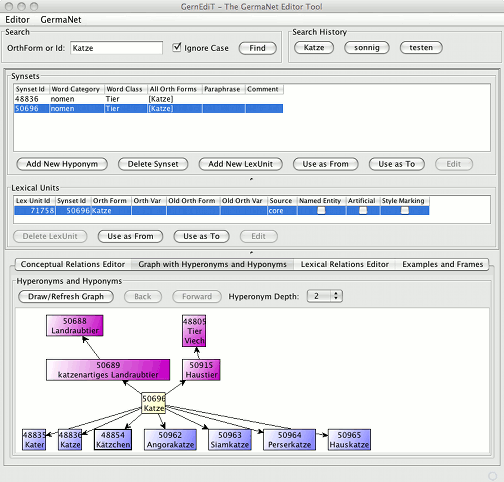How do I access the data?
Once you have signed the licence, you will get the data distribution
as an archive, typically sent as an e-mail attachment. The data are in XML format,
the DTDs which describe these formats are part of the distribution. We offer several tools and application programming interfaces
with which this data can be accessed.
Application Programming Interfaces
There are several Application Programming Interfaces (API) available for Java and for Perl.
These APIs provide easy access to all information in GermaNet.
All APIs reflect the structure of GermaNet, but not all reflect the newest version of GermaNet.
You get all APIs for free, but you are kindly requested to report bugs to the developers.
- Java API 7.0: You will soon be able to download the
latest version (7.0) of
the Java API here. This API can be used for GermaNet version 7.x.
For documentation, please see the enclosed tutorial or the online
Javadoc-documentation.
Please note that the distribution does not contain the source code. To
obtain the source code, or if you have any other questions and remarks,
please contact Verena Henrich.
- Java API 6.0.1: You can download version 6.0.1 of
the Java API here. This API can be used for GermaNet version 6.x.
For documentation, please see the enclosed tutorial or the online
Javadoc-documentation.
Please note that the distribution does not contain the source code. To
obtain the source code, or if you have any other questions and remarks,
please contact Verena Henrich.
- Java API 2.0.2: You can download version 2.0.2 of
the Java API here. This API can be used for GermaNet version 5.2 and 5.3.
For documentation, please see the enclosed tutorial or the online
Javadoc-documentation.
Please note that the distribution does not contain the source code. To
obtain the source code, or if you have any other questions and remarks,
please contact Verena Henrich.
- Java API 1.2: You can download version 1.2 of
the Java API here. This API can be used for GermaNet until version 5.1.
Please note that due to the changes on the GermaNet data content, it was necessary to
adapt the API correspondingly. Thus all programs that are using a previous version of the APIs
(under 2.0) have to be revised to the new API. To obtain the source code, or if you have any other questions and remarks,
please contact Marie Hinrichs.
- Perl APIs: To obtain Holger Wunsch's Perl API, please see:
https://code.google.com/p/perlapi4germanet/.
GermaNet-Explorer
GermaNet-Explorer is a software to visualize GermaNet. It allows to show all lexical units (word senses) and
synsets of a word. Furthermore, it can represent all semantic relations in a structured manner. A visual graph-based
navigation through GermaNet is possible.
This software was originally developed in the context of the project "Hypertextualisierung auf
textgrammatischer Grundlage" (HyTex) at the University of Dortmund. You can find further documentation on the
project page. GermaNet-Explorer was
programmed by Marc Finthammer, University of Dortmund, and
adapted to the new Java API 2.0 (see above) by
Verena Henrich, University of Tübingen.
XQuery Scripts to Convert GermaNet into Wordnet-LMF
There are two XQuery scripts for converting GermaNet to Wordnet-LMF available (see page on
Wordnet-LMF for further details):
If you have any questions or remarks, please contact
Verena Henrich.
GernEdiT - The GermaNet Editing Tool
GernEdiT is a graphical editor that allows maintaining the GermaNet data in a
user-friendly way. It is used by the lexicographers to enter lexicographic data into the
GermaNet database. A screenshot of GernEdiT is shown in
Figure 1. Some flash movies show GernEdiT in action:
- GernEdiT flash movie 1: Basic search functionality, conceptual relations list, hyperonymy graph, frames and examples, view editing history with its filtering functionality, list with all lexical units
- GernEdiT flash movie 2: Add new conceptual relation, delete conceptual relation, follow conceptual relation, list with all synsets with its search and filter functionlities
- GernEdiT flash movie 3: Insert new synset with lexical unit, insert new lexical unit, delete lexical unit, delete synset
The tool can also be used to export all GermaNet data into the
distribution format XML.

Figure 1: Screenshot of GernEdiT - The GermaNet Editing Tool